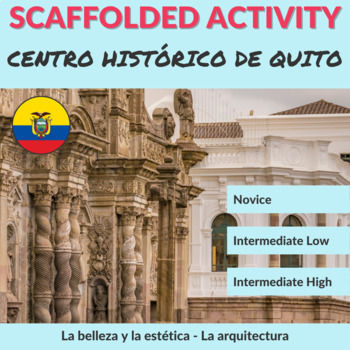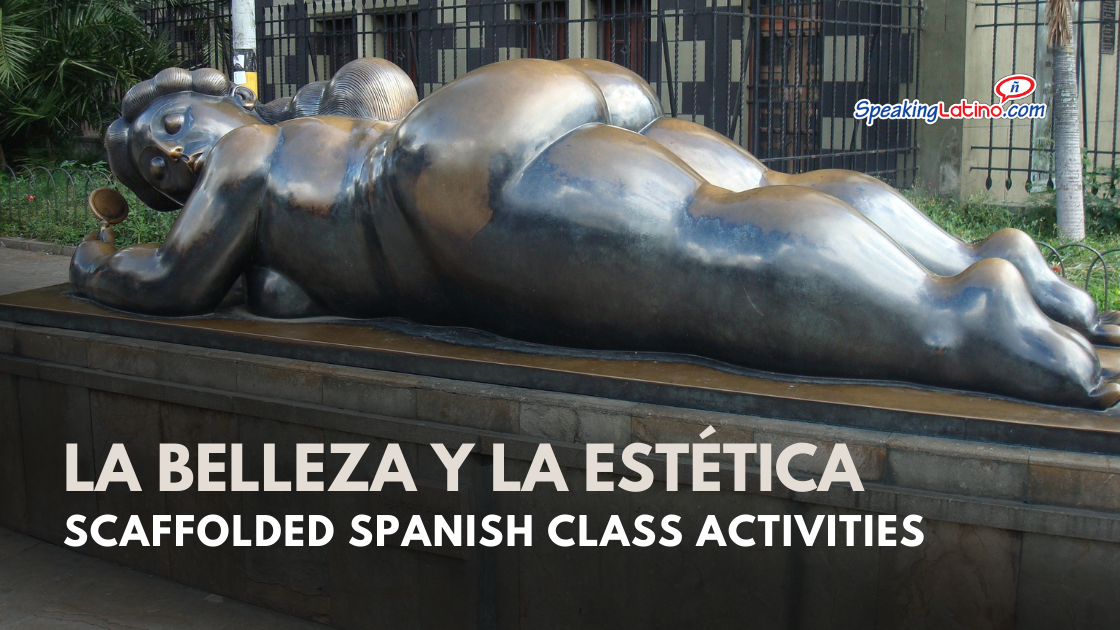
When teaching Spanish, cultural activities play a pivotal role in enriching students' understanding of the language, fostering cultural appreciation, and honing language skills.
Offering a versatile repertoire of engaging activities spanning diverse topics ensures a rich and adaptable learning experience for students of all Spanish proficiency levels. Emphasizing the significance of a commonly employed AP Spanish theme such as La belleza y la estética, these curated activities serve as potent tools to enrich Spanish education from novice to advanced.
Bridging Language and Culture
A window into Spanish-speaking cultures
These activities serve as windows into the richness of Spanish-speaking cultures. By exploring topics such as beauty standards, natural wonders, historic centers, and artistic expressions, students gain valuable insights into the customs, traditions, and societal norms prevalent in Spanish-speaking countries. This cultural immersion not only broadens students' perspectives but also fosters empathy, tolerance, and cross-cultural understanding.
A platform for language practice
In addition, these activities provide a platform for language practice and skill development. From novice to advanced levels, students engage in reading comprehension, vocabulary building, writing exercises, and oral presentations tailored to their proficiency levels. By interacting with authentic cultural content, students enhance their language proficiency, expand their vocabulary, and improve their communication skills in Spanish.
Encouraging critical thinking
Furthermore, these scaffolded activities encourage critical thinking and creativity among students. Whether analyzing beauty standards influenced by immigration, comparing natural wonders, or proposing cultural events, students are prompted to think critically, express their opinions, and engage in meaningful discussions. This cultivates analytical skills, problem-solving abilities, and the confidence to articulate ideas effectively in Spanish.
La belleza y la estética: 14 scaffolded cultural activities
The suggested topics and tasks included in these activities promote a holistic approach to language learning by integrating cultural, linguistic, and cognitive dimensions.
By immersing students in real-world cultural contexts, the activities make language learning more relevant, engaging, and meaningful. Students not only learn the language but also develop a deeper appreciation for the interconnectedness of language, culture, and society.
The following activities include 3 versions so it can be completed by novice, intermediate low/mid, and intermediate-high/advanced students.
1. La diseñadora afrolatina – Moda y diseño (Colombia)
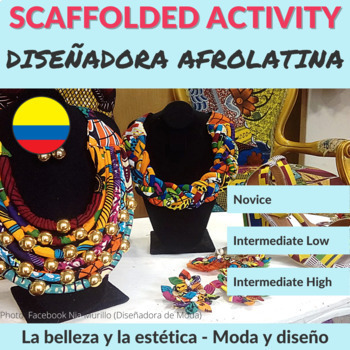
With these visual comprehensions and writing activities, students learn about Nia Murillo, a designer from Colombia that promotes its ethnicity with her work.
- Novice students read text clips about Nia’s designs and answer true or false reading comprehension questions. They also match clothing vocabulary words with images of her designs.
- Intermediate Low/Mid students read text clips about Nia’s designs and answer questions to express their opinions in Spanish. They also write descriptions of some of Nia’s designs by incorporating adjectives words given.
- Intermediate High/Advanced students read text clips about Nia’s designs and answer questions to express their opinions in Spanish. They will also work on a small project of creating an Afro-Latino brand and create a social media post to promote it.
2. Belleza venezolana cambia a las argentinas – Definiciones de belleza (Argentina)
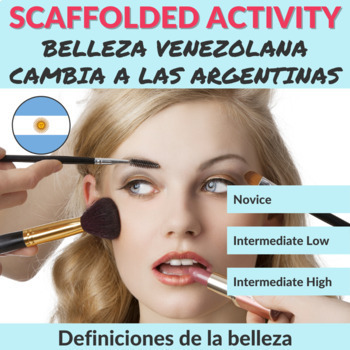
In this reading comprehension activity, students read about how the concept of beauty is changing in Argentina and how Venezuelan immigration has influenced this change.
Why your students will love ❤️ this activity: Students will find the combination of culture and beauty very interesting! They learn about different Latin American countries and how immigration impacts a community.
- Novice students read a text published in an Argentinian newspaper, learn vocabulary in context and use visual content to learn body parts vocabulary.
- Intermediate Low/Mid students also answer questions in Spanish.
- Intermediate High/Advanced students read the complete article and answer questions, and then prepare a presentation where they compare different cultures.
3. Carretas de Comida (Colombia)
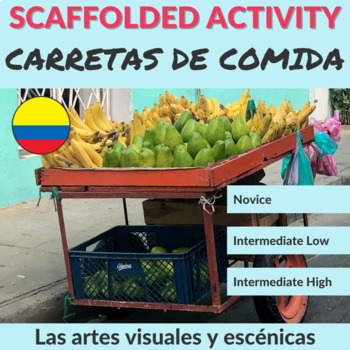
In this cultural comparison oral activity, the students are encouraged to talk about carretas/carritos de comida, a selling system in Colombia, and how people shop for food in Latin American countries.
Why your students will love ❤️ this activity: This activity will make your students think and learn about how different everyday life is around the world, and it will bring them closer to Latin American customs. It will make them want to run and buy delicious and home-made food in the carritos!
- Novice students read about what carretas/carritos de comida are, what they sell and where they are in Colombia and Latin America; they compare the system used in Colombia to their communities.
- Intermediate Low/Mid students read and talk about the different ways and places of shopping for food; they compare and contrast Colombian carretas/carritos de comida to their own communities’ way of shopping.
- Intermediate High/Advanced students are encouraged to think and talk about how different selling and buying habits are according to the cultural environment where people live, and they describe the systems in the regions where they have lived or live now.
4. Centro Histórico – Arquitectura (Ecuador)
In this reading comprehension, writing, and cultural comparison activity students learn about Quito’s historic center and its architecture.
- Novice students complete an activity with cognates and a writing challenge.
- Intermediate Low/Mid students read an introductory text about Quito’s historic center and work on a writing activity to identify the main idea of the text as well as adjectives and other phrases to describe the Historic Center.
- Intermediate High/Advanced students work in groups on writing and cultural comparison activities.
5. Comuna 13 – Las artes visuales y escénicas (Colombia)

With this reading comprehension activity, students learn about Comuna 13, a neighborhood with artistic graffiti in Colombia.
Why your students will ❤️ this activity: We are sure your students will be fascinated with this story! They will talk about expressions of art, graffiti, crime stories, urban legends, and infamous characters, which they will compare to their own neighborhoods.
- Novice students read a short text and identify common nouns related to neighborhoods and adjectives to describe the esthetics of a community.
- Intermediate Low/Mid students learn expressions to describe cognates and compare them to their own city.
- Intermediate High/Advanced students are asked to read part of an online article and extract information to discuss and compare the different ways of living.
6. Eva Perón – Definiciones de belleza (Argentina)

In this Reading Comprehension activity, students learn about Eva Perón, her life, and political activity. They are encouraged to think how her life impacted fashion, rights and women’s life in Argentina.
Why your students will love ❤️ this activity: While female empowerment is much stronger today, this Reading Comprehension activity accompanied by a video will teach your students how an Argentinian lady from the 1950s was able to defeat old fashioned customs and, at the same time, become a fashion reference.
- Novice students read an extract from a Wikipedia text about Evita, identify the best title for the article, learn Spanish words in context and watch a video to talk about the First Lady.
- Intermediate Low/Mid students read the text and answer questions in Spanish, identify what a list of terms refer to in the text, and watch the video to talk about her life.
- Intermediate High/Advanced students read the complete article, and have to write a formal letter to thank Eva Perón for her strength and legacy.
7. Fernando Botero – Las artes visuales y escénicas (Colombia)
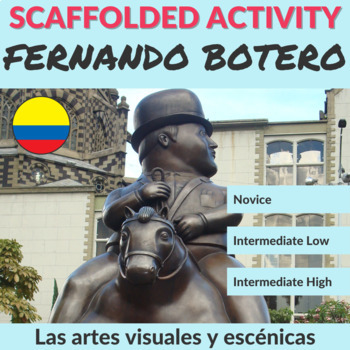
In this reading comprehension activity, the students learn about the Colombian artist Fernando Botero, his art, style, and life. They also describe his paintings and identify how his work relates to Medellín, Colombia.
Why your students will love ❤️ this activity: Your students will explore the particular style of Fernando Botero! And we know they will appreciate Botero’s unique style and have the opportunity to discuss the different ideas of beauty.
- Novice students read a short biography about Fernando Botero and learn about his work and life, answer personal questions, and identify and learn parts of a sentence, focusing on the adjectives to describe his works of art.
- Intermediate Low/Mid students talk about what Botero’s different pieces of art have in common, how he developed his style and they compare the paintings, sculptures, and drawings.
- Intermediate High/Advanced students read a detailed biography of Botero and descriptions of his pieces of art; they analyze different sculptures and paintings and talk about his style and career.
8. Listas de guapos – Definiciones de belleza (Argentina)
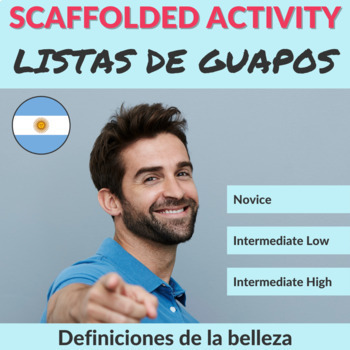
In this writing and speaking activity, students read an article about a ranking of the ‘guapos’ in Argentina, and debate and write giving opinions about the concept of beauty around the world.
Why your students will love ❤️ this activity: Students learn the ‘lunfardo’ from Argentina, its local vocabulary, give their opinions about beauty, and will sure love to share their own rankings!
- Novice students read the article and the list published in a magazine, write personal information and describe physical traits.
- Intermediate Low/Mid students compare orally the concept of beauty in Argentina and other countries after going over other similar rankings.
- Intermediate High/Advanced students read the complete article and brainstorm ideas to write a persuasive article giving their opinions about these rankings.
9. Maravillas naturales – Definiciones de belleza (Argentina)
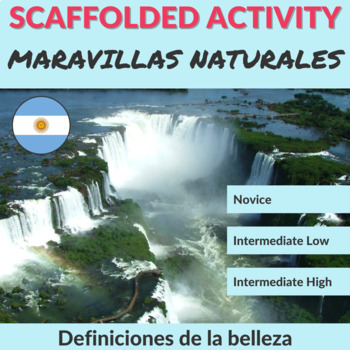
In this reading comprehension activity, students read about the natural wonders from Argentina, compare it to other rankings, and talk about natural landscapes around the world.
Why your students will love ❤️ this activity: Students discover wonderful places from Argentina and vote, debate and choose their own wonders! It is an ideal activity to use videos and geography platforms.
- Novice students read a short text, look at images, and match them to sentences written in Spanish.
- Intermediate Low/Mid students brainstorm their own list of Wonders from their countries and compare it to their classmates.
- Intermediate High/Advanced students read a longer text, answer questions written in Spanish, and prepare a visual and oral presentation to vote for the wonders they consider they should be in the list in their community.
10. Miss Ecuador – Definiciones de belleza (Ecuador)
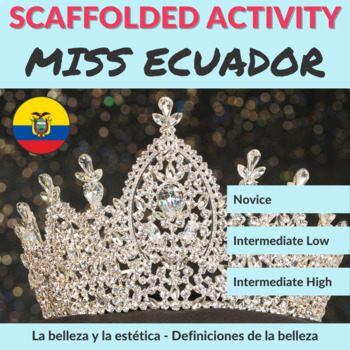
This visual interpretation activity introduces students to Miss Ecuador, the most important beauty pageant in Ecuador.
- Novice students pair the images of the special awards given in the pageant with the text. Then they put in order the syllables of some vocabulary words.
- Intermediate Low/Mid students also work with the special awards photos and answer some questions about the text.
- Intermediate High/Advanced students get the role of judge panel of the pageant to select a new Miss Ecuador.
11. Festival Funka Fest – Las artes visuales y escénicas (Ecuador)
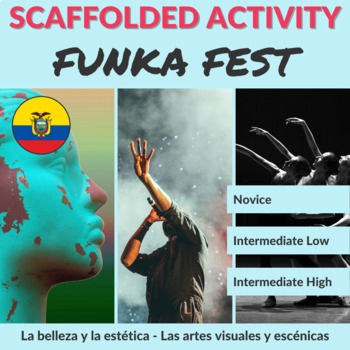
With this writing and reading comprehension activity students learn about the Funka Fest and event featuring visual arts, performing arts, music, and culinary arts.
- Novice students use visual clues to guess the meaning of words presented in the text, then they write a brief description of a type of art to be featured at the festival.
- Intermediate low-mid students are presented with a promotional visual of the festival to answer the questions about it.
- Intermediate high-advanced students works in group to prepare a written proposal to create an event similar to the Funka Fest at school.
12. La Poesía Ecuatoriana – Lenguaje y literatura (Ecuador)
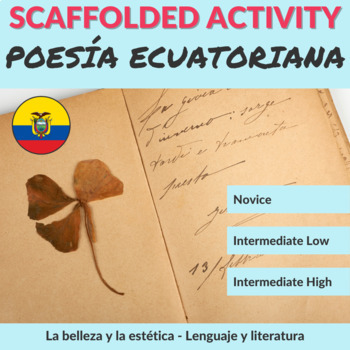
With this listening comprehension activity, students are introduced to some poets from Ecuador and work by listening to the poem Tu cabellera by Humberto Fierro.
- Novice students complete the poem with clues from a word bank.
- Intermediate-low mid students complete the poem without the word bank and answer some comprehension questions.
- Intermediate-high students complete the poem without the word bank, reflect on this type of literature, and find synonyms for some words from the poem.
13. La belleza indígena – Definiciones de belleza
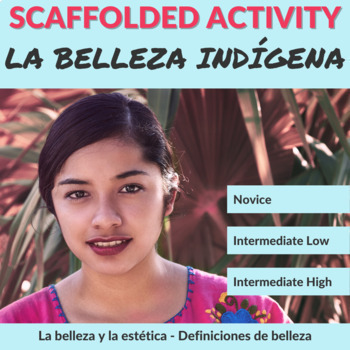
Speaking production activity for novice, intermediate, and advanced students to practice physical traits vocabulary and descriptions.
You can use this activity any time during the school year or around specific dates like: International Day of the World’s Indigenous Peoples or Día de los Pueblos Originarios (August 9th) o Indigenous People’s Day or Día de los Pueblos Indígenas (Columbus Day).
14. El cabello afro al natural – Definiciones de belleza (Colombia)
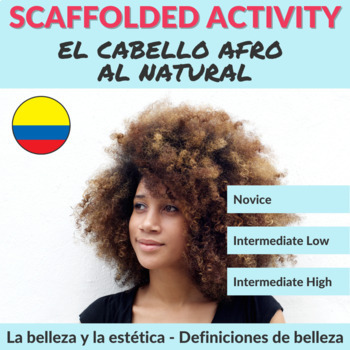
In this reading comprehension, writing, and speaking activities, students learn about 5 influencers from Colombia who uses social media to promote the natural beauty of natural afro hair.
- Novice students: After reading some text snippets, students identify the words in Spanish from the text. They also use a short authentic quote from one of the influencers to guess the meaning of 4 vocabulary words.
- Intermediate Low/Mid students: After reading some text snippets, students write a short essay reflecting on the message from these influencers. They also select one of the influencers and follow up on what they are currently doing in social media to empower women.
- Intermedia High/Advanced: Students read the story of the influencer @cirlepelobueno and answer questions related to her experience. They continue discovering the other influencers by reading some text snippets and orally reflecting on their message. They also select one of the influencers and follow up on what they are currently doing in social media to empower women.
Activities with Relevant Topics for Spanish Students
The topics covered in these activities are highly relevant for students learning Spanish as they provide cultural context, language practice, and opportunities for critical thinking.
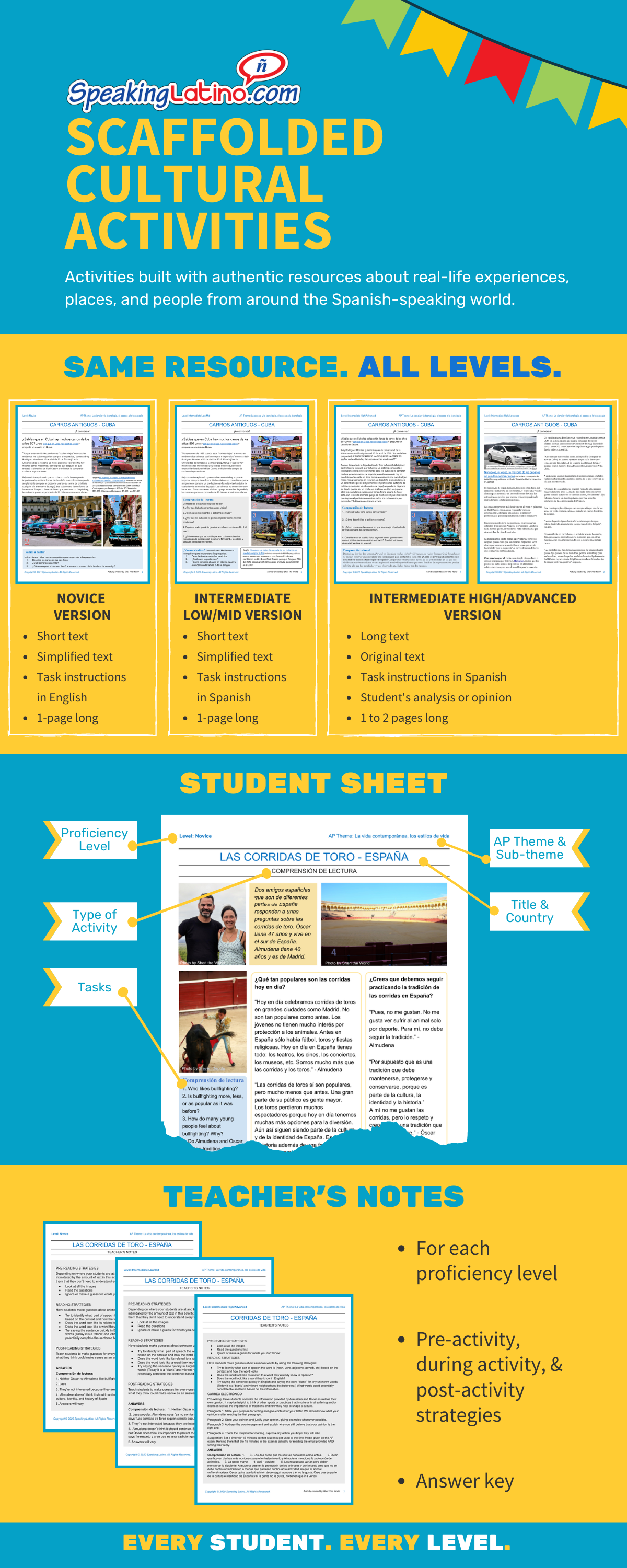
- Beauty and Immigration
Understanding how beauty standards evolve due to immigration helps students grasp cultural dynamics and societal influences in Spanish-speaking countries. - Natural Wonders
Exploring natural wonders fosters an appreciation for the diverse landscapes of Spanish-speaking regions and encourages students to engage with geography and environmental topics in Spanish. - Historic Centers
Learning about historic centers like Quito's offers insights into the rich history, architecture, and cultural heritage of Spanish-speaking cities, enhancing students' cultural awareness and vocabulary. - Urban Culture
Exploring Comuna 13 in Colombia provides a window into urban culture, street art, and community resilience, allowing students to connect with social issues and artistic expressions in Spanish. - Afro-Latina Designer
Discovering Afro-Latina designer Nia Murillo showcases diversity in fashion and cultural representation, encouraging students to explore identity, creativity, and entrepreneurship in the Spanish-speaking world. - Beauty Pageants
Engaging with beauty pageants like Miss Ecuador offers insights into beauty standards, cultural values, and media representation, prompting students to analyze societal norms and perceptions in Spanish-speaking countries. - Cultural Events
Learning about cultural events like Funka Fest exposes students to the arts, music, and culinary traditions of Spanish-speaking communities, fostering appreciation for creativity and cultural expression in Spanish. - Poetry
Exploring Ecuadorian poetry introduces students to literary traditions, language nuances, and artistic expressions, enhancing their language skills and cultural understanding through the lens of literature.
By delving into these diverse topics, students not only improve their Spanish language proficiency but also gain a deeper understanding of the cultural richness and diversity of Argentina, Colombia, and Ecuador.
Multifaceted approach to Spanish language education
By exposing diverse cultural topics, honing language skills, fostering critical thinking, and promoting cultural appreciation, this set of activities provide a multifaceted approach to Spanish language education. Through these engaging and educational experiences, students not only improve their Spanish proficiency but also embark on a transformative cultural exploration that enriches their language learning experience.
The value of using these activities lies in their ability to inspire, educate, and empower students to become not just proficient Spanish speakers, but informed global citizens with a deep appreciation for the beauty and diversity of Spanish-speaking cultures.
Endless Options to Explore More Cultural Themes
Explore the additional set of activities to enrich your Spanish classes with a wider range of cultural topics tailored to every proficiency level.
1. La belleza y la estética - Activities tailored to different proficiency levels, exploring diverse cultural topics related to beauty, aesthetics, and heritage in Argentina, Colombia, and Ecuador. Through a combination of reading comprehension, vocabulary building, and critical thinking exercises, students enhance their Spanish language skills while gaining valuable insights into the richness of Spanish-speaking cultures.
2. La Identidad Pública y Privada - These suggested activities designed around the AP Spanish theme of La identidad pública y privada or public identities in the Spanish-speaking world, but they have been also adapted for students at novice and intermediate proficiency levels.
3. La Vida Contemporánea - This set of activities cover cultural topics such as canopy tours in Monteverde, Costa Rica, bullfighting in Spain, Antonio Gaudí’s architecture in Barcelona, and the Plaza de España. These topics offer insights into diverse aspects of Hispanic culture, fostering intercultural understanding and language proficiency among students.
4. Las Familias y las Comunidades - Dive into traditions, values, and challenges faced by families and communities in the Spanish-speaking world with differentiated activities featuring Peru, Dominican Republic, Chile, and Uruguay.
5. La Ciencia y la Tecnología - Students engage in various activities that explore the theme of science and technology in Colombia, Paraguay, Guatemala, Cuba, and among indigenous communities.
6. Los Desafíos Mundiales - Explore global challenges across all student's level with these activities featuring Puerto Rico and Equatorial Guinea. They will get to explore topics like natural disasters, environmental conservation, social challenges, and cultural aspects. It's all about real-world issues while improving their Spanish skills.
7. Afro-Latinos Scaffolded Cultural Activities - Use these scaffolded activities in any order during Black History Month or through the school year. Each activity includes 3 versions to use with novice, intermediate low-mid, and intermediate high-advanced students.
